Venus Express: Mission Diary
Venus Express was successfully launched on the morning of the 9th november of 2005. Here you can find an informal diary of the mission. A more formal diary of the mission can be found here.
It is the first ESA mission to Venus and it uses a large part of the technology developed for the ESA missions Mars Express and Rosseta.
It will study the atmosphere, surface and space environment of Venus.
Onboard the spacecraft there are 9 different instruments including VIRTIS (Visible and Infrared Thermal Imaging Spectrometer),
in which data analysis our team participates.
See the latest news over the Venus Express Mission in the ESA portal:
ESA description of the VENUS Express Mission
You can quickly navigate this diary from the following links:
Venus Express: Reading the clouds
December 2008: Atmospheric structure and dynamics of the ultraviolet marks in the clouds of Venus
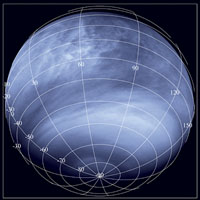 The clouds of Venus present distinctive patterns and markings visible in ultraviolet light, a wavelength the human eye can not see.
The cause of the markings is the inhomogeneous distribution of a mysterious chemical in the atmosphere that absorbs ultraviolet light, creating the bright and dark zones.
The clouds of Venus present distinctive patterns and markings visible in ultraviolet light, a wavelength the human eye can not see.
The cause of the markings is the inhomogeneous distribution of a mysterious chemical in the atmosphere that absorbs ultraviolet light, creating the bright and dark zones.
Observing Venus in infrared light thermal information from the planet can be gathered and used to understand the dynamics of this peculiar atmosphere.
With data from Venus Express instruments VMC (a visual camera well suited to study the planet in UV) and VIRTIS (a visual spectrometer able to study the temperature distribution in the planet), scientists have learnt that the equatorial areas on Venus that appear dark in ultraviolet light are regions of relatively high temperature, where intense convection brings up dark material from below.
In contrast, the bright regions at mid-latitudes are areas where the temperature in the atmosphere decreases with depth.
Variable temperature and dynamical conditions at the Venus cloud tops are the cause of the global ultraviolet pattern.
 This series of images in the left show the structure of the upper clouds observed in ultraviolet light with snapshots of the thermal structure obtained with the VIRTIS instrument.
This series of images in the left show the structure of the upper clouds observed in ultraviolet light with snapshots of the thermal structure obtained with the VIRTIS instrument.
More information in the ESA press release.
The full study is being published in the prestigious journal Nature by D. Titov and colleagues.
Three-dimensional View of Venus Atmosphere
September 2008: A 3-D view of the winds on Venus with VIRTIS data
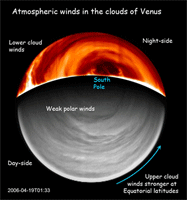 Images acquired from the VIRTIS instrument onboard Venus Express have been used to track cloud features at different
vertical levels producing a first global view of the winds on Venus from 45-70 km altitude. Agustin Sánchez-Lavega,
from the Universidad del País Vasco in Bilbao, Spain, led the research on 3-D wind mapping with data
from the first year of VIRTIS observations. The scientific study has been published on the
Geophysical Research Letters scientific journal and merited a cover on the journal.
Images acquired from the VIRTIS instrument onboard Venus Express have been used to track cloud features at different
vertical levels producing a first global view of the winds on Venus from 45-70 km altitude. Agustin Sánchez-Lavega,
from the Universidad del País Vasco in Bilbao, Spain, led the research on 3-D wind mapping with data
from the first year of VIRTIS observations. The scientific study has been published on the
Geophysical Research Letters scientific journal and merited a cover on the journal.
The winds are stronger in the upper clouds at equatorial latitudes with wind speeds of 110 m/s. They decrease
to 60-70 m/s in the lower cloud at these latitudes, but at latitudes poleward of 50ºS they are virtually the same
in the three layers decreasing to zero as they approach the Pole.
Besides this global view of the winds the research hinted to a global variation of the
wind in the upper levels produced by the solar insolation (a solar tide wind component) and to other
variations that need to be looked in deeper detail.
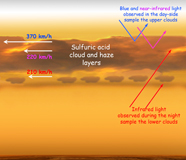 Tracking the clouds at different altitudes is possible only if the instrument is able to look
through the curtain of clouds. VIRTIS operates at different wavelengths, each of which penetrates
the cloud layer to a different altitude.
The results were obtained by tracking cloud features observed on the day-side in ultraviolet light reflected
in the upper clouds and in near infrared light a bit deeper. Infrared images obtained from the night-side
were used to track the deeper levels.
Our team, with collaborations from the VIRTIS instrument co-Is,
followed the movement of hundreds of clouds in each cloud layer. This had never been done before at
such large temporal and spatial scales, and with multi-wavelength coverage.
Tracking the clouds at different altitudes is possible only if the instrument is able to look
through the curtain of clouds. VIRTIS operates at different wavelengths, each of which penetrates
the cloud layer to a different altitude.
The results were obtained by tracking cloud features observed on the day-side in ultraviolet light reflected
in the upper clouds and in near infrared light a bit deeper. Infrared images obtained from the night-side
were used to track the deeper levels.
Our team, with collaborations from the VIRTIS instrument co-Is,
followed the movement of hundreds of clouds in each cloud layer. This had never been done before at
such large temporal and spatial scales, and with multi-wavelength coverage.
Click on the images for a larger version.
The official ESA press release can be accesed
here.
You may also read the story on Astronomy Now online
Venus Monitoring Camera goes Public
August 2008:The European Space Agency has initiated the scientific release of data from the Venus Monitoring Camera
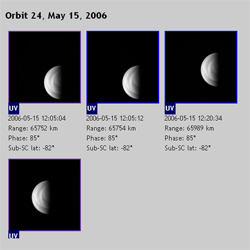 Space Agencies release the bulk of the scientific data after a "propietary period".
This means than after the data has been released any scientist with the will to analyze
data from a spacecraft mission can do it. Now image data from the Venus Monitoring Camera
of the first 300 orbits is now available from the
archive at ESA
and also with a previsualization of the data from the Planetary Society. This is only the first of many data releases that will help the scientific community to study and hopefully understand Venus.
Those interested in lookig to the data themselves can use NasaView
Space Agencies release the bulk of the scientific data after a "propietary period".
This means than after the data has been released any scientist with the will to analyze
data from a spacecraft mission can do it. Now image data from the Venus Monitoring Camera
of the first 300 orbits is now available from the
archive at ESA
and also with a previsualization of the data from the Planetary Society. This is only the first of many data releases that will help the scientific community to study and hopefully understand Venus.
Those interested in lookig to the data themselves can use NasaView
Hydroxyl molecules found on Venus
May 2008: Hydroxyl molecules found shining in Venus' upper atmosphere
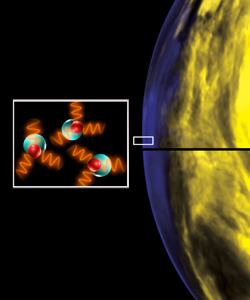 Venus Express has detected the molecule hydroxyl (OH) on another planet. This is the first time this molecule is found on another
planet atmosphere. The molecule was found because it produces a characteristic "airglow" visible on the night-side of the planet by the VIRTIS instrument. The airglow is similar but much fainter to the oxygen airglow intensively researched on Venus and subject of previous
entries in this blog. In this case the hydroxyl airglow is produced in a narrow layer of 5 km 100 km above the surface.
The detection of these molecules is important because hydroxyl molecules (formed by an oxygen and hydrogen atom) are very reactive and,
although present only in low abundances, can drive important chemical reactions.
On Earth, the glow of hydroxyl in the atmosphere has been shown to be closely linked to the abundance of ozone and
from this study, the same is thought to be true at Venus and scientists can now estimate the amount of ozone in
the planet's atmosphere.
Venus Express has detected the molecule hydroxyl (OH) on another planet. This is the first time this molecule is found on another
planet atmosphere. The molecule was found because it produces a characteristic "airglow" visible on the night-side of the planet by the VIRTIS instrument. The airglow is similar but much fainter to the oxygen airglow intensively researched on Venus and subject of previous
entries in this blog. In this case the hydroxyl airglow is produced in a narrow layer of 5 km 100 km above the surface.
The detection of these molecules is important because hydroxyl molecules (formed by an oxygen and hydrogen atom) are very reactive and,
although present only in low abundances, can drive important chemical reactions.
On Earth, the glow of hydroxyl in the atmosphere has been shown to be closely linked to the abundance of ozone and
from this study, the same is thought to be true at Venus and scientists can now estimate the amount of ozone in
the planet's atmosphere.
See the ESA press relase
on this link .
The scientific paper detailing the detection of hydroxyl in the atmosphere of Venus has been published in
Astronomy & Astrophysics Letters.
Two years observing Venus
11 April 2008: The Venus Express spacecraft has fullfilled two years of observations of Venus from its polar orbit.
After two years of observations,
more than 150 Gbytes of information about Venus have been obtained (this is the equivalent to 34 DVDs).
The European Space Agency reports that the Venus Express Orbiter is in good health obtaining data over
the surface of the planet, its atmosphere and its space environment. The spacecraft continues its
search of active volcanoes
and the research over the
South polar vortex and its surprising changes.
Two years since launch
9th november 2007: Two years since launch have passed with continous observations of Venus since April 2006.
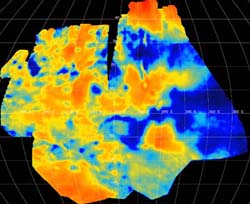 Venus is completely covered by thick clouds of sulfuric acid droplets mixed with some water.
The clouds are so thick that visible light from the Sun barely reaches the surface and can not
escape the atmosphere back to allow direct observations of the surface. Still, the surface is
very hot due to the green-house effect and cools down by emiting infrared radiation as all bodies
do. The infrared light is also stopped by the clouds but a slight part of it manages to escape through
the dense clouds. About 1000 individual images of Venus obtained with the Venus Monitoring Camera (VMC)
from April to August 2007 were used to construct an unique view of the surface in the infrared.
The pictures were taken in a particular spectral window at the wavelength of 1 micrometre. Therefore, not only atmospheric
science is being done with Venus Express but also Geology of this world. The VIRTIS instrument on Venus Express is also
routinely used for these studies of the intriguing Venus surface.
Venus is completely covered by thick clouds of sulfuric acid droplets mixed with some water.
The clouds are so thick that visible light from the Sun barely reaches the surface and can not
escape the atmosphere back to allow direct observations of the surface. Still, the surface is
very hot due to the green-house effect and cools down by emiting infrared radiation as all bodies
do. The infrared light is also stopped by the clouds but a slight part of it manages to escape through
the dense clouds. About 1000 individual images of Venus obtained with the Venus Monitoring Camera (VMC)
from April to August 2007 were used to construct an unique view of the surface in the infrared.
The pictures were taken in a particular spectral window at the wavelength of 1 micrometre. Therefore, not only atmospheric
science is being done with Venus Express but also Geology of this world. The VIRTIS instrument on Venus Express is also
routinely used for these studies of the intriguing Venus surface.
Here is the related ESA press release.
Venus: A more Earth-like planet
29th november 2007: The first results from Venus Express have been published on Nature.
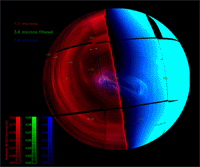 The latest results from Venus Express have been published on the prestigious journal Nature. They include 8 scientific works about
the atmosphere of Venus and its interaction with the solar environment. Among them, there are findings related with the dynamics
of the Venusian atmosphere and its double Southern polar vortex and the behaviour of the upper atmosphere 100 km above the surface.
There are also new studies of the clouds morphology and the global meteorology of Venus. VEX has also proved that lightning is
common in this atmosphere, something odd since the sulfuric acid clouds of Venus are quite different from those on Earth and lightning
should not be produced at this rate. Very importantly, the chemistry of the upper atmosphere leads to conclusions about past ages on Venus
where the planet contained far more water than today suggesting a climate and an atmosphere more similar to Earth's one. The escape of atoms
from the massive atmosphere of Venus and the evolution of Venus atmosphere over geological ages has been addreses on this Nature review.
For the scientific team the publication of these articles is just the beginning of their journey to discover the previously veiled secrets of Venus.
The latest results from Venus Express have been published on the prestigious journal Nature. They include 8 scientific works about
the atmosphere of Venus and its interaction with the solar environment. Among them, there are findings related with the dynamics
of the Venusian atmosphere and its double Southern polar vortex and the behaviour of the upper atmosphere 100 km above the surface.
There are also new studies of the clouds morphology and the global meteorology of Venus. VEX has also proved that lightning is
common in this atmosphere, something odd since the sulfuric acid clouds of Venus are quite different from those on Earth and lightning
should not be produced at this rate. Very importantly, the chemistry of the upper atmosphere leads to conclusions about past ages on Venus
where the planet contained far more water than today suggesting a climate and an atmosphere more similar to Earth's one. The escape of atoms
from the massive atmosphere of Venus and the evolution of Venus atmosphere over geological ages has been addreses on this Nature review.
For the scientific team the publication of these articles is just the beginning of their journey to discover the previously veiled secrets of Venus.
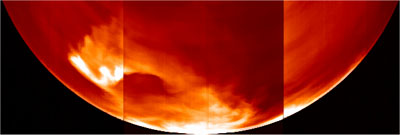 Images here display the activity of the double southern polar vortex and the airglow activity caused by oxygen atoms forming molecular oxygen and
radiating infrared light on the planet's night-side.
Images here display the activity of the double southern polar vortex and the airglow activity caused by oxygen atoms forming molecular oxygen and
radiating infrared light on the planet's night-side.
LINKS:
Follow this link to The Nature articles on Venus Express.
See here the dedicated ESA webpage about the Venus Express findings published on Nature
Among the 2007 favourites research works in Nature
20 December 2007: Nature's manuscript editors made a
selection of favourites from the papers published in 2007. The set of Venus Express papers were cited in this short list
of science highlights. The touch of Venus achieved by Venus Express will continue to expand as the New Year 2008 passes.
Webpage created: 09/11/2005. Last update: 29/11/2007.
 December 2008: Atmospheric structure of the ultraviolet marks in the clouds of Venus
December 2008: Atmospheric structure of the ultraviolet marks in the clouds of Venus September 2008: A 3-D view of the winds in Venus with VIRTIS data
September 2008: A 3-D view of the winds in Venus with VIRTIS data August 2008: ESA releases part of the VMC scientific data
August 2008: ESA releases part of the VMC scientific data May 2008: Hydroxyl molecules found on Venus
May 2008: Hydroxyl molecules found on Venus April 2008: Two years observing Venus
April 2008: Two years observing Venus November 2007: Two years around Venus
November 2007: Two years around Venus November 2007: Venus: A more Earth-like planet
November 2007: Venus: A more Earth-like planet December 2007: Among the Nature editors favourites
December 2007: Among the Nature editors favourites



 Space Agencies release the bulk of the scientific data after a "propietary period".
This means than after the data has been released any scientist with the will to analyze
data from a spacecraft mission can do it. Now image data from the Venus Monitoring Camera
of the first 300 orbits is now available from the
Space Agencies release the bulk of the scientific data after a "propietary period".
This means than after the data has been released any scientist with the will to analyze
data from a spacecraft mission can do it. Now image data from the Venus Monitoring Camera
of the first 300 orbits is now available from the
 Venus Express has detected the molecule hydroxyl (OH) on another planet. This is the first time this molecule is found on another
planet atmosphere. The molecule was found because it produces a characteristic "airglow" visible on the night-side of the planet by the VIRTIS instrument. The airglow is similar but much fainter to the oxygen airglow intensively researched on Venus and subject of previous
entries in this blog. In this case the hydroxyl airglow is produced in a narrow layer of 5 km 100 km above the surface.
The detection of these molecules is important because hydroxyl molecules (formed by an oxygen and hydrogen atom) are very reactive and,
although present only in low abundances, can drive important chemical reactions.
On Earth, the glow of hydroxyl in the atmosphere has been shown to be closely linked to the abundance of ozone and
from this study, the same is thought to be true at Venus and scientists can now estimate the amount of ozone in
the planet's atmosphere.
Venus Express has detected the molecule hydroxyl (OH) on another planet. This is the first time this molecule is found on another
planet atmosphere. The molecule was found because it produces a characteristic "airglow" visible on the night-side of the planet by the VIRTIS instrument. The airglow is similar but much fainter to the oxygen airglow intensively researched on Venus and subject of previous
entries in this blog. In this case the hydroxyl airglow is produced in a narrow layer of 5 km 100 km above the surface.
The detection of these molecules is important because hydroxyl molecules (formed by an oxygen and hydrogen atom) are very reactive and,
although present only in low abundances, can drive important chemical reactions.
On Earth, the glow of hydroxyl in the atmosphere has been shown to be closely linked to the abundance of ozone and
from this study, the same is thought to be true at Venus and scientists can now estimate the amount of ozone in
the planet's atmosphere.


 Images here display the activity of the double southern polar vortex and the airglow activity caused by oxygen atoms forming molecular oxygen and
radiating infrared light on the planet's night-side.
Images here display the activity of the double southern polar vortex and the airglow activity caused by oxygen atoms forming molecular oxygen and
radiating infrared light on the planet's night-side.